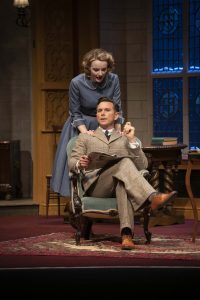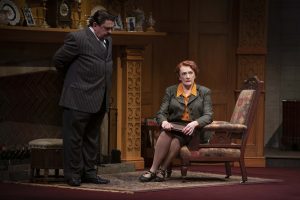Theatre Royal, October 9
7/10
Nostalgia is more usually triggered by a smell, a song or a book than by a play. But, uniquely with The Mousetrap, a creeping sense of nostalgia is almost as important as the impact of the story, characters and performances – and that’s regardless of whether you’re among the millions who’ve already seen it in London, where it’s played continuously since 1952 (with one 14-month Covid break), obliterating the longest-running-play record before the 1950s were out.

Perhaps the nostalgia is partly stirred up by our having become so accustomed to the unmistakable style of Agatha Christie’s other comedic whodunits about Hercule Poirot or Miss Marples, whether via the original novels or their film and TV counterparts. Perhaps it relates to the charmingly old-fashioned idea of story and characters being dominant, and theme being almost a foreign concept: something that happens in other countries, centuries or decades. The nearest thing to a theme in The Mousetrap is the foibles of fallible humans, and the story, meanwhile, treats time like a hot bath, in which it luxuriates while establishing itself, in a way that now would be edited to oblivion.
Perhaps, too, this nostalgia is triggered by Isabel Hudson’s take on Roger Furse’s original set design, which has an elaborate literalness more usually associated with cinema than stage these days (and is elegantly lit by Trudy Dalgleish). And then there are the performances, which aim for a certain naturalism, but are made slightly arch by Christie’s dialogue and by her sly, knowing winks to the audience.
The story, of course, is replete with all the red herrings that are the obligatory entree to a fishy murder investigation. I can’t detail what happens without spoiling the mystery for those yet to see it, so let’s just say there’s been a murder before the play starts, which sets off a chain of events at Monkswell Manor, a boutique hotel where the guests find themselves snowbound and isolated, possibly with a murderer in their midst. Dangerous place, England – and that was before Liz Truss got her hands on it.

Robin Nevin has expertly directed this old chestnut, assembling Anna O’Byrne and Tom Conroy as the leads, with Alex Rathgeber, Laurence Boxhall, Adam Murphy, Charlotte Friels, Geraldine Turner (as the hard-boiled Mrs Boyle) and a hugely entertaining Gerry Connolly (as the dubious foreigner, Paravicini, whose accent is as fruity as a Christmas pudding).
For those familiar with Tom Stoppard’s very funny The Real Inspector Hound, this is the show it was parodying. Indeed, it parodies itself with its radio crime reports miraculously describing exactly what’s happening on stage, and all Christie’s characters are capable of delivering amusing lines, whether they know it or not.
Beyond the interleaved layers of wit and archness, there’s also some typically cunning Christie plotting in Act Two, when she finally accelerates her narrative just a little, by breaking down the ensemble scenes to a deft series of duets between guesthouse owner Molly (O’Byrne) and variously Detective Sergeant Trotter (an admirable Conroy, fresh from his memorable role in Tell Me I’m Here at Belvoir), the daffy Hugh Grant-like Wren (Boxhall), and her jealous husband (Alex Rathgeber), and then Trotter with Paravicini and with the enigmatic Miss Casewell (Friels).
Paravicini is a chorus-like character who delivers handy bits of pith like “What an inconvenience the husband always is” and “I always think explanations are best left until the end”. He’s right, so you have to go and find out what happens for yourself.